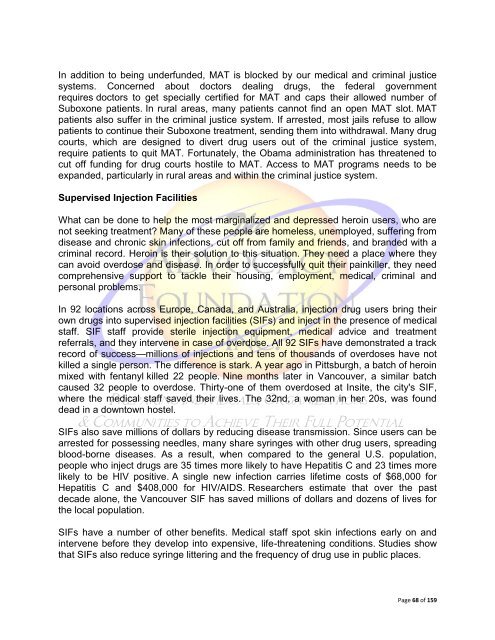The Economic Consequences of Opioid Addiction in America
The Economic Consequences of Opioid Addiction in America
The Economic Consequences of Opioid Addiction in America
You also want an ePaper? Increase the reach of your titles
YUMPU automatically turns print PDFs into web optimized ePapers that Google loves.
In addition to be<strong>in</strong>g underfunded, MAT is blocked by our medical and crim<strong>in</strong>al justice<br />
systems. Concerned about doctors deal<strong>in</strong>g drugs, the federal government<br />
requires doctors to get specially certified for MAT and caps their allowed number <strong>of</strong><br />
Suboxone patients. In rural areas, many patients cannot f<strong>in</strong>d an open MAT slot. MAT<br />
patients also suffer <strong>in</strong> the crim<strong>in</strong>al justice system. If arrested, most jails refuse to allow<br />
patients to cont<strong>in</strong>ue their Suboxone treatment, send<strong>in</strong>g them <strong>in</strong>to withdrawal. Many drug<br />
courts, which are designed to divert drug users out <strong>of</strong> the crim<strong>in</strong>al justice system,<br />
require patients to quit MAT. Fortunately, the Obama adm<strong>in</strong>istration has threatened to<br />
cut <strong>of</strong>f fund<strong>in</strong>g for drug courts hostile to MAT. Access to MAT programs needs to be<br />
expanded, particularly <strong>in</strong> rural areas and with<strong>in</strong> the crim<strong>in</strong>al justice system.<br />
Supervised Injection Facilities<br />
What can be done to help the most marg<strong>in</strong>alized and depressed hero<strong>in</strong> users, who are<br />
not seek<strong>in</strong>g treatment? Many <strong>of</strong> these people are homeless, unemployed, suffer<strong>in</strong>g from<br />
disease and chronic sk<strong>in</strong> <strong>in</strong>fections, cut <strong>of</strong>f from family and friends, and branded with a<br />
crim<strong>in</strong>al record. Hero<strong>in</strong> is their solution to this situation. <strong>The</strong>y need a place where they<br />
can avoid overdose and disease. In order to successfully quit their pa<strong>in</strong>killer, they need<br />
comprehensive support to tackle their hous<strong>in</strong>g, employment, medical, crim<strong>in</strong>al and<br />
personal problems.<br />
In 92 locations across Europe, Canada, and Australia, <strong>in</strong>jection drug users br<strong>in</strong>g their<br />
own drugs <strong>in</strong>to supervised <strong>in</strong>jection facilities (SIFs) and <strong>in</strong>ject <strong>in</strong> the presence <strong>of</strong> medical<br />
staff. SIF staff provide sterile <strong>in</strong>jection equipment, medical advice and treatment<br />
referrals, and they <strong>in</strong>tervene <strong>in</strong> case <strong>of</strong> overdose. All 92 SIFs have demonstrated a track<br />
record <strong>of</strong> success—millions <strong>of</strong> <strong>in</strong>jections and tens <strong>of</strong> thousands <strong>of</strong> overdoses have not<br />
killed a s<strong>in</strong>gle person. <strong>The</strong> difference is stark. A year ago <strong>in</strong> Pittsburgh, a batch <strong>of</strong> hero<strong>in</strong><br />
mixed with fentanyl killed 22 people. N<strong>in</strong>e months later <strong>in</strong> Vancouver, a similar batch<br />
caused 32 people to overdose. Thirty-one <strong>of</strong> them overdosed at Insite, the city's SIF,<br />
where the medical staff saved their lives. <strong>The</strong> 32nd, a woman <strong>in</strong> her 20s, was found<br />
dead <strong>in</strong> a downtown hostel.<br />
SIFs also save millions <strong>of</strong> dollars by reduc<strong>in</strong>g disease transmission. S<strong>in</strong>ce users can be<br />
arrested for possess<strong>in</strong>g needles, many share syr<strong>in</strong>ges with other drug users, spread<strong>in</strong>g<br />
blood-borne diseases. As a result, when compared to the general U.S. population,<br />
people who <strong>in</strong>ject drugs are 35 times more likely to have Hepatitis C and 23 times more<br />
likely to be HIV positive. A s<strong>in</strong>gle new <strong>in</strong>fection carries lifetime costs <strong>of</strong> $68,000 for<br />
Hepatitis C and $408,000 for HIV/AIDS. Researchers estimate that over the past<br />
decade alone, the Vancouver SIF has saved millions <strong>of</strong> dollars and dozens <strong>of</strong> lives for<br />
the local population.<br />
SIFs have a number <strong>of</strong> other benefits. Medical staff spot sk<strong>in</strong> <strong>in</strong>fections early on and<br />
<strong>in</strong>tervene before they develop <strong>in</strong>to expensive, life-threaten<strong>in</strong>g conditions. Studies show<br />
that SIFs also reduce syr<strong>in</strong>ge litter<strong>in</strong>g and the frequency <strong>of</strong> drug use <strong>in</strong> public places.<br />
Page 68 <strong>of</strong> 159

















